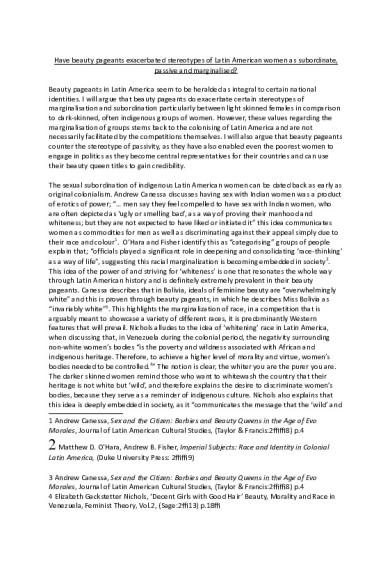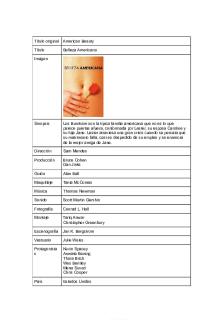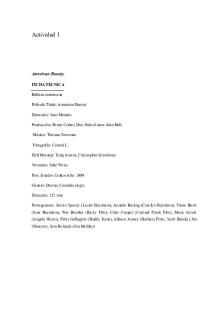Have beauty pageants exacerbated stereotypes of Latin American women as subordinate PDF

| Title | Have beauty pageants exacerbated stereotypes of Latin American women as subordinate |
|---|---|
| Course | From Football to Farandula:Latin American History 1916-2010 |
| Institution | University of Bristol |
| Pages | 5 |
| File Size | 123.3 KB |
| File Type | |
| Total Downloads | 78 |
| Total Views | 113 |
Summary
Download Have beauty pageants exacerbated stereotypes of Latin American women as subordinate PDF
Description
Have beauty pageants exacerbated stereotypes of Latin American women as subordinate, passive and marginalised? Beauty pageants in Latin America seem to be heralded as integral to certain national identities. I will argue that beauty pageants do exacerbate certain stereotypes of marginalisation and subordination particularly between light skinned females in comparison to dark-skinned, often indigenous groups of women. However, these values regarding the marginalisation of groups stems back to the colonising of Latin America and are not necessarily facilitated by the competitions themselves. I will also argue that beauty pageants counter the stereotype of passivity, as they have also enabled even the poorest women to engage in politics as they become central representatives for their countries and can use their beauty queen titles to gain credibility. The sexual subordination of indigenous Latin American women can be dated back as early as original colonialism. Andrew Canessa discusses having sex with Indian women was a product of erotics of power; “… men say they feel compelled to have sex with Indian women, who are often depicted as ‘ugly or smelling bad’, as a way of proving their manhood and whiteness; but they are not expected to have liked or initiated it” this idea communicates women as commodities for men as well as discriminating against their appeal simply due to their race and colour1. O’Hara and Fisher identify this as “categorising” groups of people explain that; “officials played a significant role in deepening and consolidating ‘race-thinking’ as a way of life”, suggesting this racial marginalization is becoming embedded in society 2. This idea of the power of and striving for ‘whiteness’ is one that resonates the whole way through Latin American history and is definitely extremely prevalent in their beauty pageants. Canessa describes that in Bolivia, ideals of feminine beauty are “overwhelmingly white” and this is proven through beauty pageants, in which he describes Miss Bolivia as “invariably white”3. This highlights the marginalization of race, in a competition that is arguably meant to showcase a variety of different races, it is predominantly Western features that will prevail. Nichols alludes to the idea of ‘whitening’ race in Latin America, when discussing that, in Venezuela during the colonial period, the negativity surrounding non-white women’s bodies “is the poverty and wildness associated with African and indigenous heritage. Therefore, to achieve a higher level of morality and virtue, women’s bodies needed to be controlled.4” The notion is clear, the whiter you are the purer you are. The darker skinned women remind those who want to whitewash the country that their heritage is not white but ‘wild’, and therefore explains the desire to discriminate women’s bodies, because they serve as a reminder of indigenous culture. Nichols also explains that this idea is deeply embedded in society, as it “communicates the message that the ‘wild’ and 1 Andrew Canessa, Sex and the Citizen: Barbies and Beauty Queens in the Age of Evo Morales, Journal of Latin American Cultural Studies, (Taylor & Francis:2008) p.4
2 Matthew D. O'Hara, Andrew B. Fisher, Imperial Subjects: Race and Identity in Colonial Latin America, (Duke University Press: 2009) 3 Andrew Canessa, Sex and the Citizen: Barbies and Beauty Queens in the Age of Evo Morales, Journal of Latin American Cultural Studies, (Taylor & Francis:2008) p.4 4 Elizabeth Gackstetter Nichols, ‘Decent Girls with Good Hair’ Beauty, Morality and Race in Venezuela, Feminist Theory, Vol.2, (Sage:2013) p.180
‘savage’ elements of African or indigenous culture that persisted in remote areas through the colonial period will ‘infect’ the pure and ancient bloodlines of the nation.5” This suggests that there was a fear amongst Venezuelans that showing indigenous heritage means admitting to being something of a savage. Therefore, Nichols explains, “to civilise, control (and whiten) the nation, women and their wild bodies must be disciplined. Hair must be straightened (or curled), skin must be lightened, and noses must be thinner.6” Imposing these Western beauty standards on indigenous women, for whom these features are uncommon, Demonstrates racial marginalization that is continued throughout history and catalysed in beauty pageants. Canessa chooses Miss Bolivia from the Miss Universe pageant of 2005 to highlight the paradox that he believes has stemmed from the colonial period that marginalizes these groups of Latin American women based on their appearance while simultaneously being subordinate to white men, by“representing national dress” and communicating the conflicting notion that “whilst indian women … are construed as sexually available to mestizos and whites, the predominant image of the desired female body is of the white woman; and whereas the indian woman’s body was accessible to creole men, the opposite was most certainly not the case” consequently by showing the light-skinned Miss Bolivia in a fashionable version of indigenous dress, she “resolves the paradox in a fantasy: the body of a white woman with the accessibility of an indian woman”7. This is an example of beauty pageants in Bolivia, exacerbating the stereotype. Canessa explains that there are two annual elections in Bolivia for Misses per year and that “they all invariably tall, white women, they are also almost always from the eastern part of the country8.” Another example of this stereotype against dark-skinned women perpetuated by pageants is the slogan comparing two Miss Venezuela candidates; “Oly Clemente para la gente decente, Yolanda Leal para gente vulgar”, Clemente was the “elite” daughter of a government minister and Leal a schoolteacher from the slums of Caracas, who was darker9. 2004’s Miss Bolivia contestant Gabriela Oviedo described the divide between the eastern and western parts of Bolivia through physical description; “from the west side of the country…very short people and Indian people” and describes people from her part of the country: “we are tall and we are white people.10” Her immediate association of Indians and people from the west being short shows how embedded the physical stereotype is within their culture, and by limiting their scope for diversity in appearance amongst women to such an extent that the candidates are all from a certain area of the country, it could be said that beauty pageants follow the colonial standards of whitening and western beauty expectations. Therefore, by default they are leaving other South American women with variation of these ideals marginalized.
5 Ibid. p.184 6 Ibid. 7 Andrew Canessa, Sex and the Citizen: Barbies and Beauty Queens in the Age of Evo Morales, Journal of Latin American Cultural Studies, (Taylor & Francis:2008) p.6 8 Ibid. p.7
9 Elizabeth Gackstetter Nichols, Beauty, Virtue, Power, and Success in Venezuela 1850– 2015, (Lexington Books: 2016) p.128 10 Ibid.
On the other hand, beauty pageants are also a grand opportunity for great success, fame, and wealth, and therefore opportunities they may not have had access to before. Stanfield highlights Luz Marina Antigua, the Miss Universe winner of 1958, as the only Colombian winner of the pageant to date, a fact that makes her a ‘national icon’11. The opportunity of becoming an icon for women in your country is undoubtedly a great honour and a difficult position to gain, and with the title come various responsibilities. Stanfield underlines some of these duties; “presenting a positive image of the nation to global media as they promote the countries products, exports and tourism potential” showing that they take on a role of advertising the countries assets using their platform of fame to facilitate doing so12. The cultural significance and high esteem in which pageants are held make this platform ideal for these women to express their views, and as Hinojosa points out, the reach of pageants is “undeniable” considering that over 78 nations send participants to Miss Universe, and in 2008 the audience for the pageant reached over one billion13. Hinojosa argues that these pageants pave a potential path to power for women as they have already taken on the role of “representing the best of what a city or nation has to offer.”14 Therefore, by default their image and behaviour post-crown are seen to encompass the values and virtue of their nation, Hinojosa analyses that beauty queens “serve as a symbolic political representative” and argues that this role is enabled to change from representational to political through “the rise of candidate-centred politics”15. Therefore, with this responsibility given to them, we could argue that this counters the stereotype suggesting that Latin American women are “passive” as they actively use their position of advanced power and attention to engage in the politics of their nation. Political parties may be attracted to proposing beauty queens as faces of their parties, because of their recognition; “they may be recognizable brands that will attract voters”, the popularity of the pageants is enough to literally make them a “brand”16. This could be seen to comply with the stereotype of South American women as commodities for men, but Hinojosa argues that this is “the new forged path to power”17. Gladys Zender, from Peru, was the first Latin American woman to win Miss Universe in 1957. In a video interview the winner speaks about what it was like being elected Miss Universe, and she describes that not only did she take on the role as an “ambassador” of her country, but the title enabled presidential doors to open for her, as everywhere she went on her campaigning for the next year, the first place they visited was the President of the Republic18. This perfectly highlights Hinojosa’s notion of a path to political power, as she is meeting world leaders thanks to the international pageant. Furthermore, her husband, the former 11 Michael Edward Stanfield, Of Beasts and Beauty: Gender and Identity in Colombia, (University of Texas Press, 2013) p.3 12 Ibid. 13 www.missuniverse.com 14 King-O’Riain, Rebecca Chiyoko, Making the Perfect Queen: The Cultural Production of Identities in Beauty Pageants. Sociology Compass (2008) 74–83.
15 Magda Hinojosa, From Miss World to World Leader: Beauty Queens, Paths to Power, and Political Representations, (Routledge: 2016) 16 Ibid. 17 Ibid. 18 https://vimeo.com/67812897 [08.01.2016]
Mayor of Lima, later in the video admits in the video that a large part of his election as Mayor was due to his marriage Miss Universe19. This shows the extreme credibility that this title carries in terms of potential new paths to power, as not only was she enabled to meet and experience the highest level of political people, the esteem was so grand that it benefits her husband’s political path also. This is particularly interesting as I have mostly discussed Latin American women’s subordination by men, and yet here is a clear example of a Peruvian woman being the tool that enables him to enhance his political abilities. This, I argue, is completely juxtaposes the notion of passivity amongst Latin American women, as their increased recognition and fame enables them to be far more active in the political field. However, this platform does seem only to be available to those who can enter and win, which automatically marginalizes indigenous and working class women who either do not have the right (western) features or may not have the money to enter or get the plastic surgeries generally required. In addition, Hinojosa explains, it is difficult for women to necessarily be taken seriously once they seek office, as their success is still based on their physical attractiveness and therefore “their appearances may harm their political credibility” and whilst they are in the public eye there is still a great focus on their physical attributes, making anything they say shrouded by interest of their appearance, or as Murray indicates; “It is … harder for a woman to get her message across if it is buried under comments about her hairstyle”. Therefore, although in this way beauty pageants could be seen to counter a stereotype, it does not necessarily liberate either, as deep-rooted sexism can constrict women from fully engaging in political power. To conclude, beauty pageants exacerbate a stereotype embedded from colonialism that dark-skinned women are subordinate to men and are less attractive than white women through their lack of diversity represented in candidates. However, for the Latin American women that can succeed in the pageants, they can be empowering and give women the platform to be represented on the global stage. BIBLIOGRAPHY Canessa, Andrew, Sex and the Citizen: Barbies and Beauty Queens in the Age of Evo Morales, Journal of Latin American Cultural Studies, (Taylor & Francis: 2008) Chiyoko, Rebecca, + O’Riain, King Making the Perfect Queen: The Cultural Production of Identities in Beauty Pageants. Sociology Compass (2008) 74–83. Fisher, A, O'Hara, M.D, Imperial Subjects: Race and Identity in Colonial Latin America, (Duke University Press: 2009) Hinojosa, Magda, From Miss World to World Leader: Beauty Queens, Paths to Power, and Political Representations, (Routledge: 2016) Nichols, E.G, ‘Decent Girls with Good Hair’ Beauty, Morality and Race in Venezuela, Feminist Theory, Vol.2, (Sage:2013) 19 Ibid.
-
Beauty, Virtue, Power, and Success in Venezuela 1850–2015, (Lexington Books: 2016)
Stanfield, M.E, Of Beasts and Beauty: Gender and Identity in Colombia, (Texas: University of Texas Press:2013) https://vimeo.com/67812897 [08.01.2016] www.missuniverse.com...
Similar Free PDFs

Beauty Pageants are Harmful
- 3 Pages

Ficha técnica American Beauty
- 2 Pages

Latin american paper - Grade: A-
- 2 Pages

SUBORDINATE CLAUSES
- 2 Pages

Subordinate Clauses
- 1 Pages

Real Beauty Vs Cliche Beauty
- 5 Pages

Glossary of Legal Latin
- 10 Pages
Popular Institutions
- Tinajero National High School - Annex
- Politeknik Caltex Riau
- Yokohama City University
- SGT University
- University of Al-Qadisiyah
- Divine Word College of Vigan
- Techniek College Rotterdam
- Universidade de Santiago
- Universiti Teknologi MARA Cawangan Johor Kampus Pasir Gudang
- Poltekkes Kemenkes Yogyakarta
- Baguio City National High School
- Colegio san marcos
- preparatoria uno
- Centro de Bachillerato Tecnológico Industrial y de Servicios No. 107
- Dalian Maritime University
- Quang Trung Secondary School
- Colegio Tecnológico en Informática
- Corporación Regional de Educación Superior
- Grupo CEDVA
- Dar Al Uloom University
- Centro de Estudios Preuniversitarios de la Universidad Nacional de Ingeniería
- 上智大学
- Aakash International School, Nuna Majara
- San Felipe Neri Catholic School
- Kang Chiao International School - New Taipei City
- Misamis Occidental National High School
- Institución Educativa Escuela Normal Juan Ladrilleros
- Kolehiyo ng Pantukan
- Batanes State College
- Instituto Continental
- Sekolah Menengah Kejuruan Kesehatan Kaltara (Tarakan)
- Colegio de La Inmaculada Concepcion - Cebu








